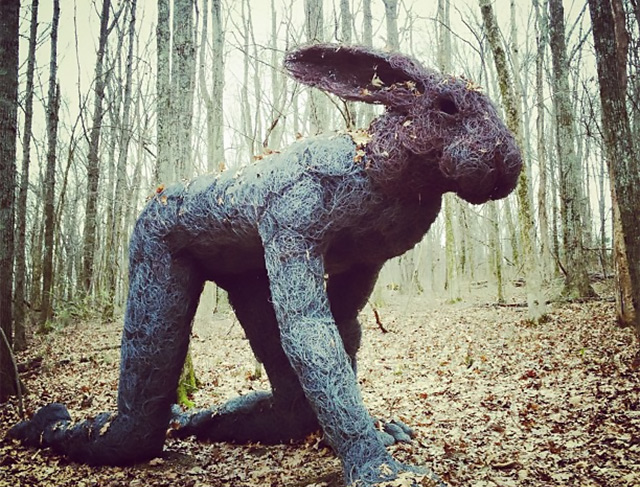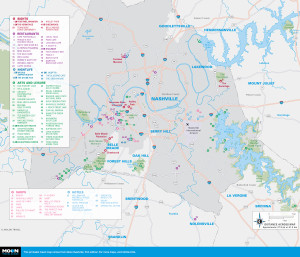
“Crawling Lady Hare” by Sophie Ryder is one of the remarkable works in Cheekwood’s Woodland Sculpture Trail. Photo © Carrie Hirsch.

Greater Nashville Area
A car is necessary to reach some of Nashville’s farther-flung sights, but it is worth filling up the tank for these attractions.The mansion at the former Belle Meade Plantationx (5025 Harding Pike, 615/356-0501, Mon.-Sat. 9am-5pm, Sun. 11am-5pm. $16) is the centerpiece of present-day Belle Meade Plantation and one of the finest old homes in the city. Its name means beautiful pasture, and indeed it was Belle Meade’s pastures that gave rise to the plantation’s fame as the home of a superb stock of horses. Purchased as 250 acres in 1807 by Virginia farmer John Harding and his wife, Susannah, the estate grew to 5,400 acres at its peak in the 1880s and 1890s.
Belle Meade was never a cotton plantation, although small amounts of the cash crop were grown here, along with fruits, vegetables, and tobacco. Instead it was the horses, including the racehorse Iroquois, that made Belle Meade famous. The mansion was built in 1820 and expanded in 1853. Its grand rooms are furnished with period antiques, more than 60 percent of which are original to the house. The estate also includes outbuildings, such as a smokehouse, dairy, and the original log cabin that Harding built for his family when they moved to Belle Meade in 1807.
The plantation also includes a slave cabin, which houses an exhibit on Belle Meade’s enslaved population, which numbered more than 160 at its peak. Two of these slaves are described in detail. Susanna Carter was the mansion’s housekeeper for more than 30 years, and she remained with the family even after the end of slavery. On her deathbed, Selena Jackson, the mistress of Belle Meade for many years, called Susanna “one of the most faithful and trusted of my friends.” The other African American who features prominently at the museum is Bob Green, whose skill and experience as a hostler earned him one of the highest salaries ever paid to a horse hand of the day. Visitors to Belle Meade are given a one-hour guided tour of the mansion and then visit the outbuildings and grounds on their own.
Plan to spend a full morning or afternoon at Cheekwood (1200 Forrest Park Dr., 615/356-8000, Tues.-Sat. 9:30am-4:30pm, Sun. 11am-4:30pm, $12 adults, $10 seniors, $5 students and children, $3 parking) so you can experience the full scope of this magnificent art museum and botanical garden. Galleries in the Cheekwood mansion house the museum’s American and European collections, including an excellent contemporary art collection. Cheekwood has the largest public collection of works by Nashville artist William Edmondson, the sculptor and stoneworker. The museum usually displays items from its permanent collection as well as traveling exhibitions from other museums. Many exhibits have special ties with Nashville.
But Cheekwood is far more than just an art museum. The mansion overlooks hundreds of acres of gardens and woods, and it is easy to forget that you are near a major American city when you’re at Cheekwood. Walk the mile-long Carell Woodland Sculpture Trail past works by 15 internationally acclaimed artists, or stroll past the water garden to the Japanese garden. There are dogwood gardens, an herb garden, a delightful boxwood garden, and much more. Wear comfortable shoes and pack a bottle of water so you can enjoy the grounds in comfort.
Cheekwood owes its existence to the success of the coffee brand Maxwell House. During the 1920s, Leslie Cheek and his wife, Mabel Wood, invested in the new coffee brand being developed by their cousin, Joel Cheek. Maxwell House proved to be a success and earned the Cheeks a fortune, which they used to buy 100 acres of land in West Nashville. The family hired New York residential and landscape architect Bryant Fleming to create a 30,000-square-foot mansion and neighboring gardens. Cheekwood was completed in 1933. Leslie Cheek lived in the mansion just two years before he died, and Mabel lived there for another decade before deeding it to her daughter and son-in-law, who later offered it as a site for a museum and garden. Cheekwood opened to the public in 1960.
The former estate of country music icon Barbara Mandrell, Fontanel Mansion (4225 Whites Creek Pike, 615/727-0304, daily 9am-3pm, $22 adults, $20 seniors, $12 children) has become a surprising draw for locals and tourists alike since it opened in 2010. These 136 acres include walking trails, an outdoor live music venue, a restaurant with its own live music, an art gallery, and a gift shop. But the main attraction is the mansion, a 27,000-square-foot log cabin, which is the city’s only country music mansion tour.
Fans get to see how the most famous of the Mandrell sisters lived before her retirement. Tours are sometimes given by Mandrell’s daughter, who throws in lots of personal tidbits (such as stories of her brothers jumping from the second story into the pool). Even those who don’t love “I Was Country When Country Wasn’t Cool” will appreciate the music history, artifacts such as Gretchen Wilson’s “Redneck Woman” Jeep, the former indoor shooting range, and the bucolic scenery and impressive architecture.
Founded in 1912, Hadley Park (1037 28th Ave. N., 615/862-8451, Mon.-Thurs. 6am-8:30pm, Fri. 6am-7:30pm, Sat. 8am-noon, $3 adults, $1.50 seniors and children) is believed to be the oldest public park developed for African Americans in the South and, most likely, the United States. The park got its start when Fisk University president George Gates requested that the city buy land and create a park for its black citizens. This was in the era of segregation, so other city parks were not open to blacks. The request was granted, and the park opened in July 1912. An old farmhouse was converted into a community center, and benches and a playground were installed. It is now home to a state-of-the-art gym and fitness center, computer labs, meeting rooms, and tennis courts.
Andrew Jackson’s plantation and home is Nashville’s best historical tourist attraction, even though it’s technically 16 miles east of the city. The Hermitage (4580 Rachel’s Ln., 615/889-2941, daily 9am-5pm, $19 adults, $16 seniors, $14 students, $9 children) is where Jackson retired following his two terms as president of the United States, and it is where he and his beloved wife, Rachel, are buried. Following President Jackson’s death, The Hermitage remained in family hands until 1853, when it was sold to the State of Tennessee to pay off the family’s debts. It opened as a museum in 1889 and was restored largely due to the persistence of the Ladies Hermitage Association. Because the property never left family hands before it was sold to the state, many of the furnishings are original, and even the wallpaper in several rooms dates back to the years when Andrew Jackson called it home.
The Hermitage tour and museum focuses not only on Jackson and the construction and decoration of the mansion, but also the African American slaves who worked at The Hermitage plantation. It makes no effort to gloss over some of Jackson’s less favorable legacies. Curators and archaeologists have studied The Hermitage to learn about the hundreds of men and women who made The Hermitage profitable and successful for so many years. The tour of the grounds takes visitors to Alfred’s Cabin, a slave cabin occupied until 1901 by former Hermitage slave Alfred Jackson. You also learn about the agriculture that took place on The Hermitage, and can see cotton being cultivated during the summer months. To learn even more about The Hermitage’s slaves, take an add-on wagon tour (Apr.-Oct., $10). Visitors to The Hermitage first watch a video about Andrew Jackson and The Hermitage, then can continue on to a museum. Even if you are not typically an audio-tour-type person, consider the one of the grounds, which includes a kids’ version narrated by Jackson’s pet parrot. Guided tours of the mansion are offered. Plan on spending at least three hours here to make the most of your visit. Try to come when the weather is good, so you can take in the grounds and not just the mansion.
Founded in 1912 as the Agricultural and Industrial State Normal College for black students, Tennessee State University (3500 John A. Merritt Blvd., 615/963-5000, daily 24 hours; campus tours June-July Mon.-Wed. 10am, Aug.-May Mon.-Fri. 10am and 2pm, free) is now a comprehensive university with more than 9,000 students. In 1979, as a result of a court order to desegregate the state’s universities, TSU merged with the Nashville campus of the University of Tennessee. Today, TSU’s student body is 75 percent African American.
Walking through the leafy, brick-building campus, which takes up more than 500 acres in North Nashville, you’ll pass the historic President’s Residence, the columned McWherter Administration Building and the modern Lawson Hall. Campus tours are offered twice daily during the school year.
Excerpted from the First Edition of Moon Nashville.